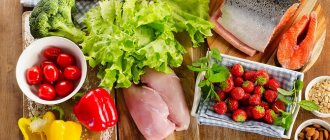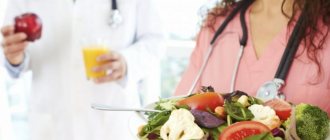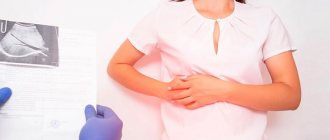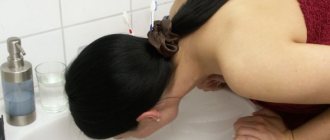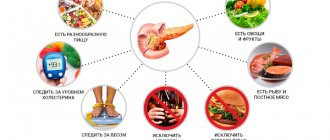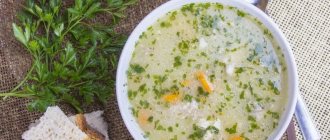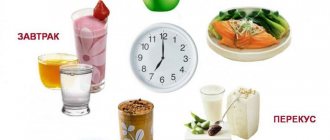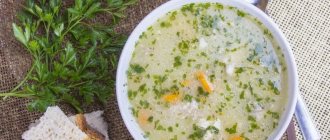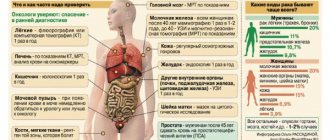Description
Full name: treatment table 4 according to Pevzner.
The main indication is prescribed for intestinal disease accompanied by diarrhea. It can be:
- colitis;
- enterocolitis;
- dysentery;
- intestinal tuberculosis;
- typhoid fever;
- food poisoning.
Goals:
- reduce inflammatory, fermentative and putrefactive processes in the gastrointestinal tract;
- provide the stomach with the most gentle mode of operation;
- normalize digestion.
How the therapeutic effect is achieved:
- products that cause fermentation and putrefactive processes and stimulate the secretion of gastric juice and bile secretion are excluded from the diet;
- The main methods of cooking are boiling and steaming;
- the consistency of the dishes is slimy, liquid or semi-liquid (for this, the products are ground or pureed);
- temperature regime of dishes - only warm, hot and cold are strictly prohibited;
- daily salt intake - no more than 10 g;
- daily water intake - no more than 2 liters;
- diet - fractional, 6 times a day.
Timeframe: minimum 3 weeks. Improvement is observed already on days 6-7. If the symptoms do not go away at the end of the recommended course, the diet is either extended by the same amount or adjusted by the attending physician depending on the course of the disease.
Daily calorie content: 2,000 kcal.
Daily norm of BZHU:
- proteins - 90 g (normal);
- fats - 70 g (reduced);
- carbohydrates - 250 g (reduced).
Treatment table No. 4 is prescribed mainly in a hospital setting.
Diagnostics
To obtain data about the lower parts of the digestive tract, fibrocolonoscopy or retromanoscopy is prescribed. These studies make it possible to detect foci of inflammation on the mucous membrane, determine intestinal tone, and its evacuation force. Foci of inflammation and other changes in the mucosa are a good reason for determining colitis. Among other studies, the state of the intestinal microflora is analyzed. In order to exclude other diseases of the digestive tract, the doctor may prescribe a blood test, stool test, ultrasound, or coprogram.
Subgroups
Depending on the symptoms and course of the disease, diet table 4 according to Pevzner has several subgroups that differ slightly in the composition of permitted products and indications.
Diet No. 4A
Indications:
- intestinal diseases occurring with mild diarrhea;
- the predominance of fermentation processes in the gastrointestinal tract;
- increased gas formation, abundant discharge of non-smelling gases;
- loss of appetite;
- fast fatiguability;
- stomach ache.
Duration: 5 days.
The main difference from the main diet is the significant limitation of foods that enhance fermentation, namely simple carbohydrates.
Daily calorie content: 1,600 kcal (the lowest calorie table in this subgroup).
BJU ratio:
- proteins - 120 g (high-protein food);
- fats - 50 g (below normal);
- carbohydrates - 150 g (low-carbohydrate diet).
A low calorie diet implies an energy deficiency, so patients who are prescribed this diet should be primarily in a supine state (bed rest).
Diet No. 4B
Indications:
- improvement after exacerbation of intestinal diseases;
- attenuation of the inflammatory process;
- moderate indigestion.
Duration: from 2 weeks to 1 month (depending on the rate of recovery).
It is stage II of the main fourth table according to Pevzner.
Main differences:
- Finely chopped and chopped dishes are allowed;
- reducing salt intake to 5-6 g per day;
- daily water intake - no more than 1.5 liters;
- The range of permitted products has been expanded: noodles, vermicelli, cream, kefir, sour cream, sweet fruits and berries are introduced.
Daily calorie content: 3,000 kcal (high-calorie food).
BJU ratio:
- proteins - 110 g;
- fats - 100 g;
- carbohydrates - 420 g.
Given the high calorie content of the diet, patients are advised to increase physical activity - walk more, do simple exercises.
Diet No. 4B
Indications:
- rehabilitation period after exacerbations of intestinal diseases;
- chronic gastrointestinal diseases in remission: colitis, ulcers, pancreatitis, cholecystitis, gastritis.
Duration: permanent.
It is the III stage of the main fourth table according to Pevzner (the sequence of prescribing diets is as follows: No. 4 - No. 4B - No. 4B).
Main differences:
- added one more method of cooking - baking in the oven;
- the diet is expanding: green beans, white cabbage, beets, green peas, tomatoes, herbs, cucumbers, and sour cream are included in limited quantities;
- not pureed, but crumbly porridges are prepared;
- You are allowed to drink whole milk.
Daily calorie content: calculated individually in accordance with body weight, age and degree of physical activity.
BJU ratio:
- proteins - 110 g;
- fats - 100 g;
- carbohydrates - 450 g.
Treatment table No. 4B is the most balanced of all in this subgroup.
Diet No. 4AG
Indication: gluten enteropathy.
Duration: permanent.
Main differences:
- Only gluten-free products are allowed;
- additional enrichment with certain vitamins and minerals: iron, calcium and folic acid.
Daily calorie content: 3,000 kcal.
BJU ratio:
- proteins - 120 g;
- fats - 100 g;
- carbohydrates - 450 g.
Since gluten enteropathy is most often a congenital pathology, people from an early age and throughout their lives eat according to diet No. 4AG.
Nutrition for colitis during exacerbation.
During an exacerbation of colitis, diet is very important. The goal of the diet is to stop inflammation in the intestines, restore proper digestion and eliminate the processes of fermentation and putrefaction.
To do this, it is recommended to completely eliminate foods that cause fermentation or rotting. For diarrhea, it is necessary to exclude foods rich in fiber, vegetables and bran. For constipation, on the contrary, you need to strengthen peristalsis and eat a lot of vegetables and cereals.
Dishes should be steamed or boiled. Food must be ground, chopped or pureed. It is better to overcook the porridge or use special porridge for baby food.
Grocery list
If treatment of gastrointestinal diseases using the fourth table according to Pevzner is carried out at home, be sure to have an accurate list of foods allowed and prohibited for this diet.
If some foods and dishes are in doubt, the best option is to consult with your doctor.
Causes
Infectious . As a rule, they are caused by pathogens of various intestinal infections, most often Salmonella and Shigella. The development of colitis is also provoked by infectious diseases (mycobacterium tuberculosis, etc.), opportunistic and saprophytic flora of the human intestine caused by dysbiosis.
Nutritional. They arise due to severe and prolonged violations of diet and nutrition. Often, concomitant gastritis develops against the background of Achilles gastritis, pancreatitis and chronic enteritis; their cause is systematic irritation of the colon mucosa due to incomplete digestion of food.
Toxic. They arise due to prolonged intoxication with compounds of lead, mercury, arsenic, phosphorus, etc. Toxic colitis of an endogenous nature can arise due to irritation of the intestinal wall by the products that it excretes, for example, in uremia, gout.
Medicinal. Their cause, as a rule, is long-term uncontrolled use of laxatives containing anthroglycoeids (preparations of buckthorn, rhubarb root, senna leaf, joster fruit, etc.). Antibiotics and some other medications also have a negative effect.
Allergic. Observed in food allergies, as well as intolerance to a number of chemical and medicinal substances, high individual sensitivity of a person to certain types of bacterial intestinal flora and decay products of microorganisms.
Recommendations
In order to correctly follow table number 4, you need to know some of the nuances of preparing dishes and consuming a number of products:
- Cook soups only with low-fat, non-concentrated broth. If possible, they should be slimy and not thick.
- Porridge - ground. Cook mainly in water, with the addition of a small amount of milk.
- Remove all fat layers, tendons, skin and fascia from meat and fish. You cannot serve it in pieces - only minced through a meat grinder, which must have a minimum hole diameter.
- Allowed vegetables are only after heat treatment. Preferably in soups. In limited quantities.
- Milk cannot be drunk separately, only when added to dishes (porridge, omelettes, puddings).
- Non-carbonated mineral water of a certain brand is prescribed by the attending physician.
It is not easy to follow treatment table 4, since you will constantly want to chew something hard, in one piece. Mashed potatoes and grated porridges quickly get boring. However, it is even more difficult to prepare dishes for him, since there are too many prohibitions and nuances.
It is for this reason that this diet is recommended to be followed in a hospital or medical sanatorium. A professional nutritionist will be able to correctly calculate both the daily calorie intake and the BJU ratio and provide for the daily intake of salt, sugar and oil. At home, it is extremely difficult to take into account all these details and do everything correctly. And every mistake can result in a worsening of the patient’s condition.
Do's and don'ts
Recommended and excluded foods and dishes of the “4 table” diet:
Table “Dos and Don’ts”
| Products and dishes | What is possible | What not to do |
| Bread and flour products | Rusks from 200 g of premium wheat bread, thinly sliced and not crispy. | Other bakery and flour products. |
| Soups | In low-fat, weak meat or fish broth with the addition of mucous decoctions of cereals, semolina, rice, boiled and pureed meat, steamed quenelles and meatballs, egg flakes. | Soups with cereals, vegetables, pasta, milk, strong and fatty broths. |
| Meat and poultry | Lean and lean varieties of beef, veal, chicken, turkey, rabbit. The meat is degreased, fascia and tendons are removed, and in birds, the skin is removed. Steamed or boiled cutlets, quenelles, meatballs. Minced meat with boiled rice instead of bread is passed through a fine grinder 3-4 times. Boiled meat soufflé. | Fatty types and varieties of meat, pieces of meat, sausages and other meat products. |
| Fish | Low-fat types of fresh fish, cut into pieces and chopped (quenelles, meatballs, cutlets), boiled in steam or water. | Fatty species, salted fish, caviar, canned food. |
| Dairy | Freshly prepared calcined or unleavened mashed cottage cheese, steam soufflé. | Whole milk and other dairy products. |
| Eggs | Up to 1-2 pieces per day. Soft-boiled, steamed omelet and in dishes. | Hard-boiled eggs, fried. |
| Cereals | Puree porridges in water or low-fat broth - rice, oatmeal, buckwheat, cereal flour. | Millet, pearl barley, barley, pasta, legumes. |
| Vegetables | Only in the form of decoctions added to soups. | — |
| Snacks | Excluded from the diet. | — |
| Fruits, sweet dishes and sweets | Jelly and jelly from blueberries, dogwoods, bird cherry, quince, pears. Mashed raw apples. Sugar - limited. | Natural fruits and berries, dried fruits, compotes, honey jam and other sweets. |
| Sauces and spices | Only low-fat broth and butter in dishes. | — |
| Beverages | Tea, especially green, black coffee and cocoa with water. Decoctions of rose hips, dried blueberries, black currants, bird cherry, quince. If tolerated, diluted fresh juices from berries and fruits, except grapes, plums, and apricots. | Coffee and cocoa with milk, carbonated and cold drinks. |
| Fats | Only fresh butter, 5 g per serving of the finished dish. | Animal and cooking fats. |
Recipes for dietary dishes for colitis.
Sample daily menu from a diet for intestinal colitis:
Breakfast:
Boiled oatmeal with butter. Apple compote.
Lunch:
Steamed beef cutlet. Blueberry jelly.
Dinner:
Rice soup with chicken meatballs. Boiled sea fish. Herb tea
Afternoon snack:
Low-fat cottage cheese casserole. Apple compote.
Dinner:
Meat casserole. Weak tea.
Before bedtime:
Compote or jelly.
Types of diets:
In case of exacerbation of chronic colitis or in acute form of colitis with loose stools (diarrhea), diet No. 4 is recommended. This diet does not recommend foods rich in fiber. All dishes that cause rotting and fermentation are also excluded.
If the disease occurs with constipation, then diet No. 3 is recommended. This diet recommends foods that enhance intestinal motility and are rich in fiber.
In case of chronic colitis without exacerbation, it is necessary to adhere to diet No. 2.
